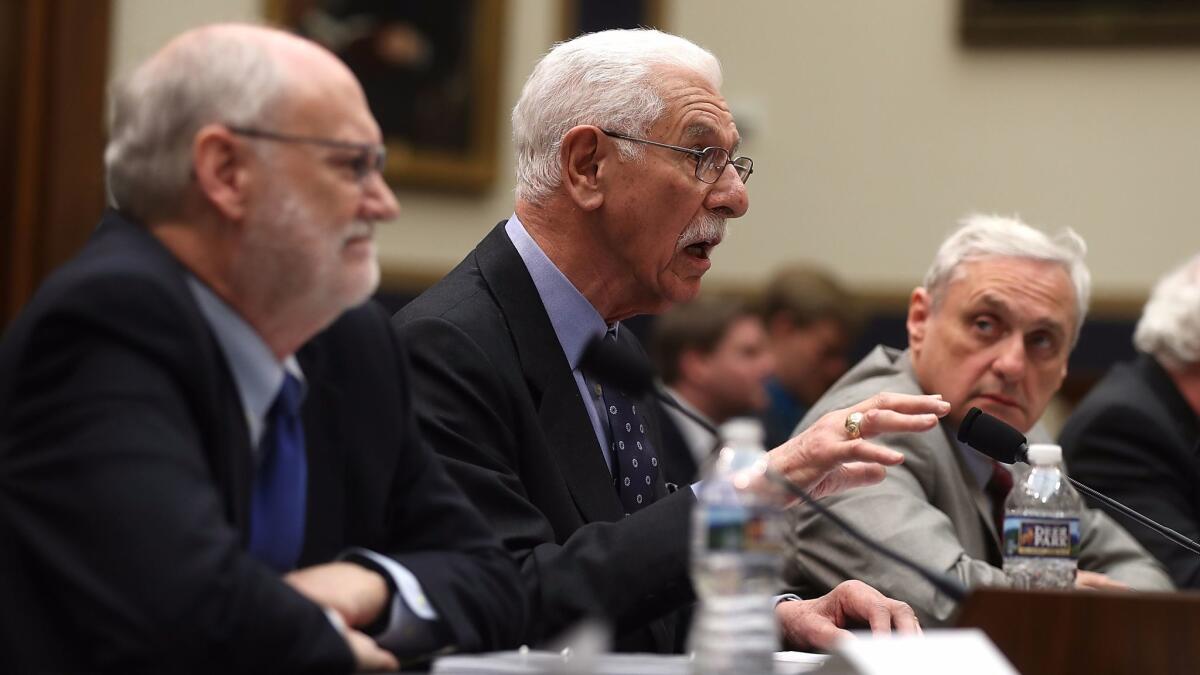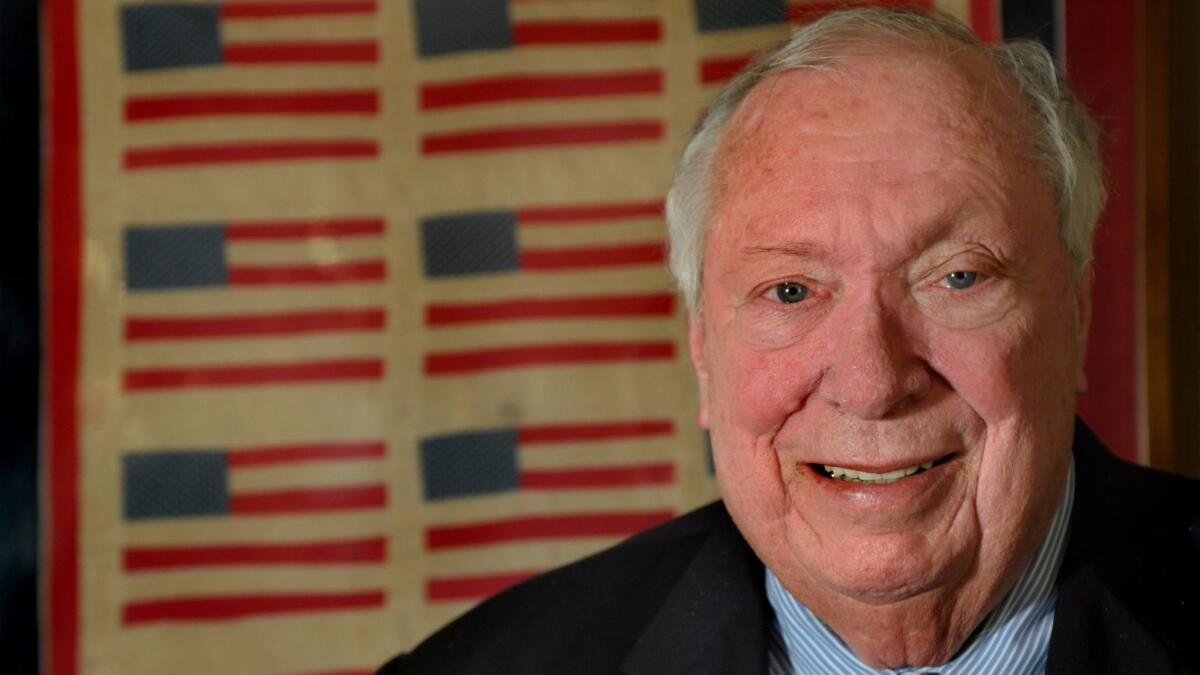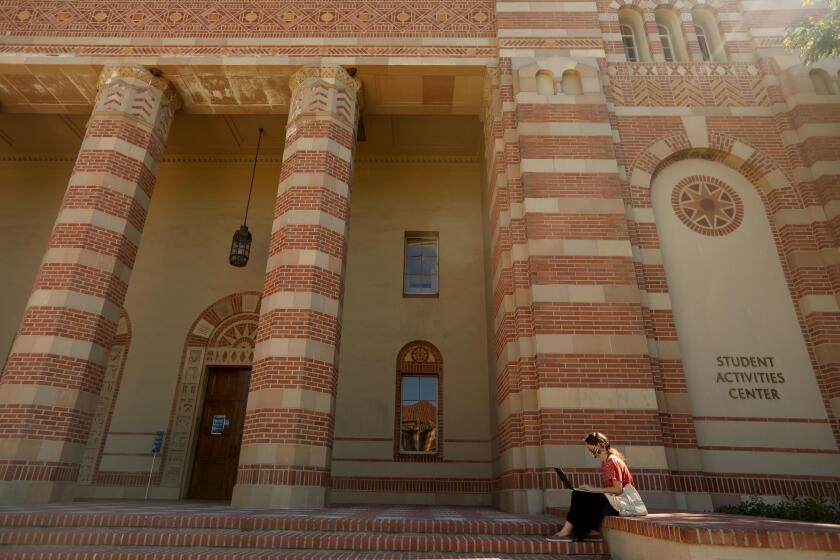Q&A: Has the 9th Circuit gone ‘bananas’? And can Trump break it up?

- Share via
Never mind that the sanctuary city ruling came from a trial judge on the district court bench in San Francisco — not the 9th Circuit appellate court.
“It’s the 9th Circuit going bananas,” White House Chief of Staff Reince Priebus told reporters after the judge blocked Trump’s order, which threatened to cut federal funds to jurisdictions that limit cooperation with immigration agents.
Trump tweeted: “First the Ninth Circuit rules against the ban & now it hits again on sanctuary cities-both ridiculous rulings. See you in the Supreme Court!”
The sanctuary ruling will not even get to the 9th Circuit until Trump appeals the lower court’s decision.
There are generally three levels of courts in the federal system: district courts, where trials are held; intermediate appellate circuit courts, which hear appeals from the lower courts; and the Supreme Court, the final arbiter of disputes.
That the 9th Circuit received blame for a decision it didn’t make reflected its long-held status as a whipping boy for conservatives. Efforts to break it up stretch back decades.
The parade for change began with a senator from Washington state whose state kept losing fishing cases in the 9th Circuit. Contentious rulings by the court over the years increased the fomentation. The 9th Circuit, for example, was the source of a ruling that the mention of God in the Pledge of Allegiance violated the Constitution. The Supreme Court overturned the decision.
Conservative critics justify a proposed breakup on the grounds that the 9th Circuit — the largest of the U.S. appeals courts in terms of judges and the population covered — is just too unwieldy.
They contend that cases would move more quickly if the court were split into more circuits.
But the main beef is political.
Judges appointed by Democratic presidents outnumber Republican appointees on the 9th Circuit by about two to one. Judge Alex Kozinski, a Republican with libertarian views appointed by President Reagan, has been quoted as saying, “You’d have to believe in the tooth fairy to say this has nothing to do with politics.”
Ninth Circuit critics believe that creating a separate circuit of the most conservative Western states would result in more conservative rulings. California now has more cases in the 9th Circuit than any other state.
A new circuit also could mean more judicial appointments for the sitting president — in this case, Trump.
What is the likelihood the 9th Circuit will be split?
Until Trump lashed out at the 9th Circuit, few believed proposed legislation to break up the circuit would succeed. Previous bills have failed. A commission created by Congress to study a breakup recommended against it.
A majority of 9th Circuit judges, including conservative Republicans, believe a breakup would be a bad idea, according to the court’s internal polling of judges. Democrats, though the minority party, also could potentially block any such move.
What would a split look like?
The circuit is made up of nine states, plus territories.
A bill sponsored by Arizona’s senators would group Alaska, Arizona, Idaho, Montana, Nevada and Washington state in one circuit. The other circuit would include California, Oregon, Hawaii and the territories of Guam and the Northern Mariana Islands.
It’s the 9th Circuit going bananas.
— White House Chief of Staff Reince Priebus
Is the 9th Circuit the most-reversed appeals court in the country?
In raw numbers, yes. But the rate at which the U.S. Supreme Court overturns 9th Circuit decisions, while higher than average, does not lead the pack.
In the most recent year for which statistics are available, the 9th Circuit ranked second in the percentage of reversals by circuit courts.
Legal scholars argue that the statistics are relatively meaningless in any case. Only a tiny percentage of a circuit’s decisions are reviewed by the Supreme Court. A circuit that had one case before the Supreme Court would have a 100% annual reversal rating if the high court overturned that decision.
There also are a variety of reasons why the Supreme Court might overturn a decision. A circuit court might follow precedent only to have the Supreme Court change the law in reviewing that circuit’s decision.
Just how liberal is the 9th Circuit?
Not as liberal as it used to be. Judges appointed by President Carter have traditionally been the most liberal, and they are retiring or taking reduced workloads. President
Do liberals deliberately file cases in 9th Circuit territory to increase their chances of winning?
Most litigants, both liberal and conservative, will seek the most sympathetic forum possible. But the ruling against Trump’s order on sanctuary jurisdictions came as a result of lawsuits filed by San Francisco and Santa Clara County. Those lawsuits had to be filed in California, and because of that, the 9th Circuit will hear Trump’s appeal.
Litigation over Trump’s executive order temporarily barring travel from six predominantly Muslim nations has been filed around the country. The 4th Circuit Court of Appeals in Virginia is scheduled to hear an appeal of a Maryland judge’s ruling against the ban early next month.
How many judges did each recent president nominate?
The 9th Circuit is made up of 44 judges. The court’s headquarters is in San Francisco. Other courthouses are located in Pasadena, Portland and Seattle. The longest-serving judge, Alfred T. Goodwin, was named by Richard Nixon in 1971. The most recent appointees, John B. Owens and Michelle T. Friedland, were named by
In all, 16 judges were chosen by Republicans and 28 by Democrats. Here's a tally of appointments by president:
Richard Nixon: 2
Jimmy Carter: 7
Ronald Reagan: 5
George H. W. Bush: 2
Bill Clinton: 14
George W. Bush: 7
Barack Obama: 7

Who are the faces of the 9th Circuit?
Dubbed the odd couple, Judges Stephen Reinhardt and Kozinski are the most prominent members of the 9th Circuit.
Reinhardt is openly critical of the conservative majority on the U.S. Supreme Court. Some legal analysts believe Reinhardt’s name on a decision makes it more likely to be reviewed by the high court.
He is widely known as the “liberal lion” of the federal appellate courts. The Carter appointee tends to rule in favor of criminal defendants and against death sentences.
If he believes a Supreme Court precedent will create an injustice, Reinhardt may distinguish the case before him from the precedent and write around it.
No judge likes to be overturned by a higher court, but Reinhardt is not afraid of it, his fellow judges say.
Reinhardt wrote the ruling that overturned
The U.S. Supreme Court overturned that ruling on the grounds that the measure’s proponents lacked standing to appeal a district judge’s decision. The Supreme Court decision nevertheless had the effect of ending the marriage ban in California.
Kozinski, who was profiled Sunday on “60 Minutes,” has a penchant for startling ideas. He suggested in a court ruling that the guillotine was the best way to execute criminals. But he advocated instead for firing squads because he said the public would never accept guillotines.
Like Reinhardt, Kozinski has chafed under Supreme Court rulings that require lower courts to defer to state judges, even if the federal judges believe the states badly erred.
Kozinski also has been a leader on the 9th Circuit in condemning prosecutorial misconduct.
UPDATES:
3:35 p.m.: This article was updated with additional details about the structure of the 9th Circuit.
This article was originally published at 1:25 p.m.
Sign up for Essential California
The most important California stories and recommendations in your inbox every morning.
You may occasionally receive promotional content from the Los Angeles Times.








